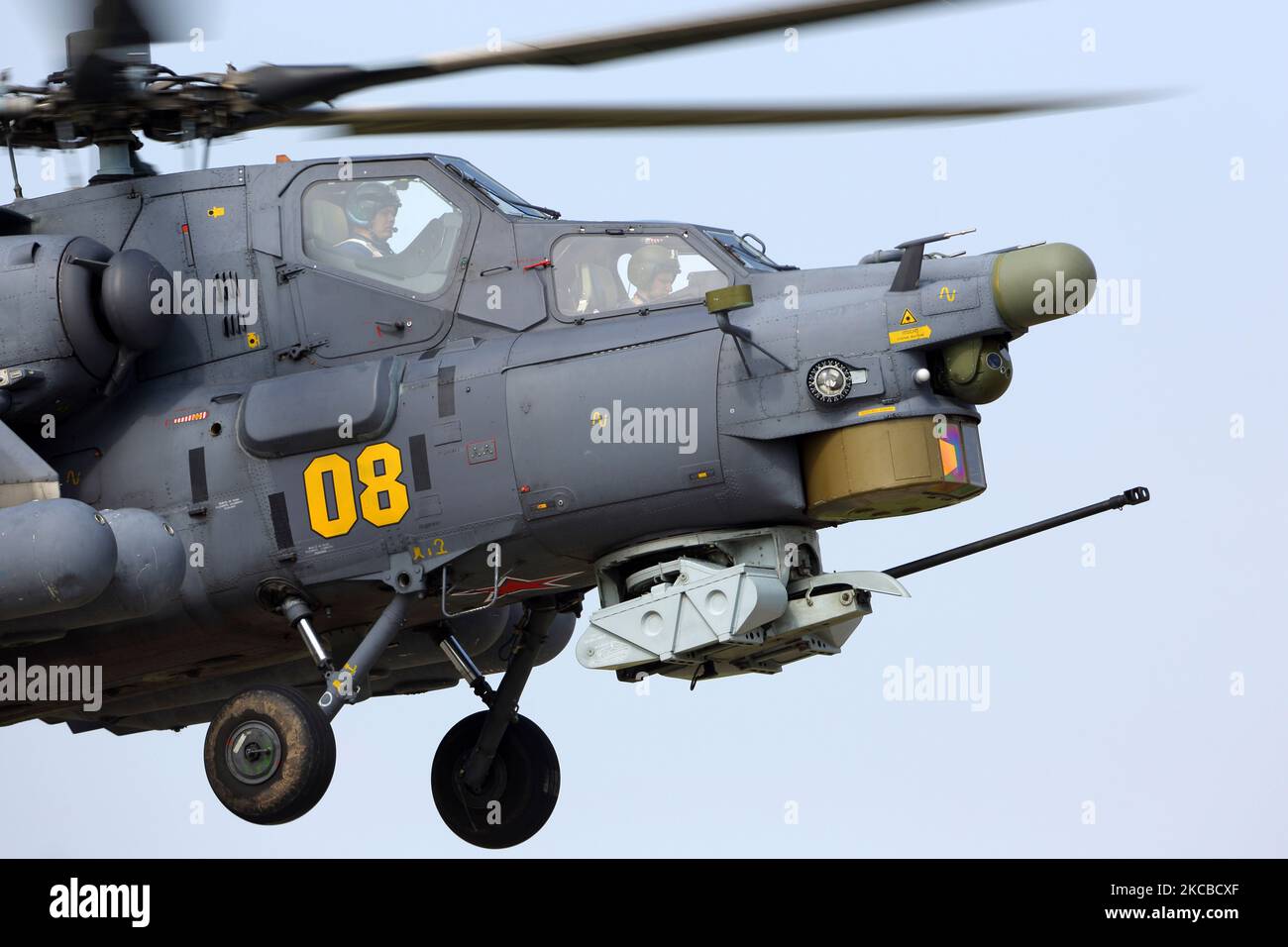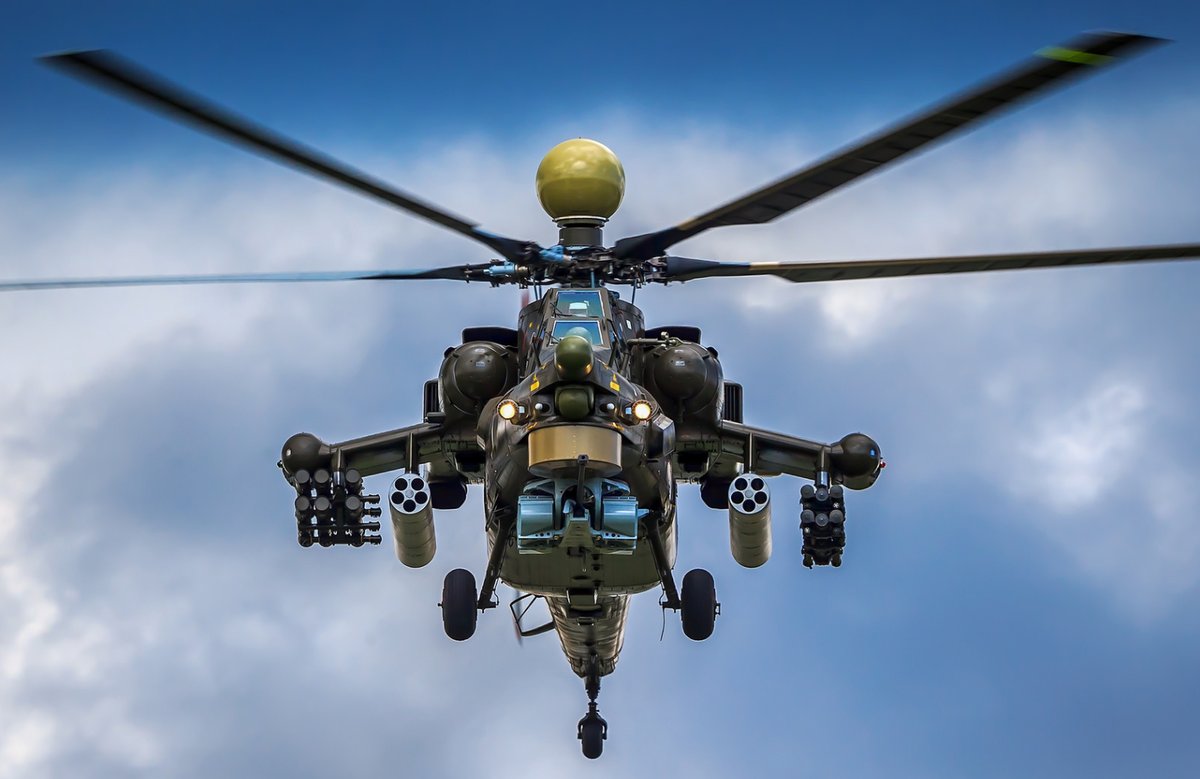Mi 28n Havoc - The Mil Mi-28 (NATO reporting name "Havoc") is a Russian two-seater anti-armor attack helicopter that can be deployed in all weather conditions, day or night. It is an attack helicopter with no secondary transport capability that is better optimized for this role than the Mil Mi-24 fighter. It carried a single gun in a barbette under the nose, plus external loads on the mast and winglets.
This section requires additional citations for verification. Please help improve this article by adding citations to authoritative sources. Unsourced content may be challenged and removed. Find source: "Mil Mi-28" – News · Newspaper · Book · Scholar · JSTOR (August 2010) (Learn how and how to remove this template message)
Mi 28n Havoc

In 1972, following the completion of the Mil Mi-24, development of a unique attack helicopter with transport capabilities began. The new design had a lower carrying capacity (3 troops instead of 8) and eliminated the cockpit to provide better overall performance and a higher speed. Improved performance was important due to its internal role to cover enemy tank and helicopter countermeasures and helicopter landing operations. At first, many different designs were considered, including an unconventional scheme with two main rotors, mounted with saddles on the wingtip (in a vertical arrangement). And similar in design to the American Lockheed AH-56 Cheyne attack helicopter of the late 1960s, the tail had an additional thrust propeller. In 1977, a prototype was built in a classic single-rotor design. It lost its resemblance to the Mi-24 and the canopies were shorter and with a flat surface.
Attack Helicopter Mi 28n Havoc With Radar Station 3d Model $149
In 1981, the design and model were adopted. The prototype (number 012) first flew on November 10, 1982.
A second example (No. 022) was completed in 1983. In 1984, the Mi-28 completed the first phase of official trials, but in October 1984 the Soviet Air Force selected the more advanced Kamov Ka-50 as its new anti-tank. The helicopter. Development of the Mi-28 continued, but was a low priority. In December 1987, production of the Mi-28 was approved at Rosvertle in Rostov-on-Don.
An early production Mi-24 was equipped as an early test of Mi-28 technology with an air data boom. Later, some Mi-24Ds were fitted with Mi-28 radome mounts to test the capabilities of the sight-flight-navigation complex, and others were designed with a similar body to the future Mi-28, but with a rounded cockpit.
In January 1988, the first Mi-28A prototype (No. 032) flew. Instead of the three-bladed version, it was equipped with a stronger saddle and an "X" type tail rotor. The Mi-28A was shown at the Paris Air Show in June 1989. In 1991, the second Mi-28A (#042) was completed. The Mi-28A program was canceled in 1993 because it was considered uncompetitive with the Ka-50, especially since it was not all-weather capable.
Mil Mi 28n Havoc (04944) 1:72 Scale Helicopter Plastic Model Kit
The Mi-28N was unveiled in 1995 with the name N meaning "Night". The prototype (number 014) first flew on November 14, 1996. Its most important feature is a circular shrouded radar above the main rotor, similar to the American AH-64D Apache Longbow radar. The Mi-28N has a reticle sight and a target device under the nose with a TV camera and FLIR. Development stopped due to financial problems. A second prototype with an improved rotor design was unveiled at Rosewart in March 2004.
The Rostvertol plant delivered about 140 Mi-28N and Mi-35M helicopters to domestic and foreign customers in 2012-2014. 28 helicopters were delivered in 2015.
Mil also produced the Mi-28N, Mi-28NE, and an export variant of the Mi-28D, a simple daily helicopter variant based on the Mi-28N design, but without radar and FLIR.
A fifth-generation derivative, the Mi-28NM, has been in development since 2008. According to Russian Helicopters CEO Andrey Shibitov, modern helicopter standards include reduced radar signature, extended flight range, improved weapons control systems. , some fighter jet capabilities and speeds of up to 600 kilometers per hour.
Mi 28n (havoc) Attack Helicopters Editorial Photo
In 2016, Russian media reported that a new, improved helmet system designed for the MI-28N to display visual information to target targets in any field.
The Mi-28 is a new generation attack helicopter that serves as an air-to-air and air-to-ground partner for the Mi-24 Hind and Ka-50 Hokum. The main five-bladed rotor is mounted above the center of the fuselage, the short, wide, tapered wings and weapons carrier are mounted behind the center of the fuselage. Two turboshaft clamps are mounted in pods near the top of the fuselage and the exhausts point downwards. The body is more slippery and deflects into the nose and tail canvas. The aircraft had a tandem, stepped cabin, a belly-mounted cannon and a non-retractable rear-wheel tricycle landing gear. Due to the landing gear and energy-absorbing seats, the crew can survive vertical falls of up to 12 m/s. The Mi-28 has a fully armored cabin, including a windshield that resists 7.62 and 12.7 mm armor-piercing rounds and 20 mm shrapnel.
The helicopter design is based on a conventional pod and boom configuration with a tail rotor. The main rotor head has elastomeric bearings and the main rotor blades are made of composite materials. The tail rotor is designed in a two-blade configuration with fully controlled X-blades. The Mi-28N Night Attack variant has a new design of all-plastic rotor blades capable of holding 30mm shells.
It is equipped with two heavily armored cockpits, 12.7 to 14.5 mm bullet resistant windshield, in-nose electronics and a narrow X (55°) tail rotor, with low noise characteristics. The engine is powered by twin Isotov TV-3-117VM (t/n 014) turboshafts with 2,200 horsepower.
Russian Helicopters Unveils Upgraded \
Although the Mi-28 is not intended for use as a transport vehicle, it has a small passenger compartment that can carry three people. Its intended purpose is to rescue the crew of the downed helicopter.
The Mi-28N has a helmet-mounted display for the pilot. The pilot assigns targets to the navigator/weapons officer who fires the weapons required to accomplish that particular mission. The integrated fire monitoring and control system has two optical channels providing a wide and narrow field, an optical TV channel with a narrow field, and a laser range finder. This system can operate at 110 degrees in azimuth and +13 to -40 degrees in elevation.
The night attack helicopter retains most of the structural design of the original Mi-28. The main difference is the installation of an integrated electronic warfare system. Other changes include a new main gearbox to transfer more power to the rotor, new high-efficiency blades with swept tips and a new fuel injection control.

The pilot uses a helmet-mounted target indicator that directs the navigator's fire observation and control system to the target. The navigator/weapons officer is able to use the weapon or gun directed against the target. The targeting system follows the pilot's eye direction.
Scale Mil Mi 28n Havoc (nose) By Coffeebean2 On Deviantart
The fleet of Russian military rotary-wing aircraft is fully equipped with the new Night Vision Goggles (NVG). Mil Mi-28N attack helicopters of the Russian Aerospace Forces (VKS) have received the GEO-ONV1 family NVG.
It features selective firing and dual feed, enabling cyclic firing rates between 200 and 800 rounds per minute.
Its effective range varies from 1500 meters for ground vehicles to 2500 meters for airborne targets. Can be used from High Explosive Rounds (HEIs) to Armored Propelling Subbots (APDS). The stated claim for the 3UBR8 round is 25mm RHA at 1500m.
The Mi-28N's standard missile armament is the 9M120 Ataka-V hypersonic missile, which uses radio beam guidance. Two racks can carry 8 Ataka missiles each, giving a total of 16 missiles, although 8 Ataka is a typical load.
Mean Havoc Rising
There are four types of Ataka missiles for different tasks. The 9M120 Tandem High Explosive Anti-Tank (HEAT) warhead is used against tanks equipped with Explosive Reactive Armor (ERA), with a stated firing capacity of 800mm Rolling Homogeneous Armor (RHA).
The thermobaric Type 9M120F is used against infantry, buildings, bunkers and caves. The 9M120O expansion rod warhead is used against helicopters. All versions have a range of 6 km. The improved version of the 9M120M has a longer range (8 km) and better penetration (900 mm RHA).
Unguided weapons such as rockets can be carried in four pylons under the winglets. The rockets typically carried are the 122 mm (4.8 in) S-13 fired from five-round B-13 rocket pods and the 80 mm (3.1 in) S-8 fired from 20-round B8V-20 pods.

The S-8 and S-13 rockets used by the Mi-28 are generally unguided. In the most common configuration, one can expect 40 S-8 or 10 S-13 rockets. Both missiles have their own variants, from heat warheads to thermobaric warheads. The S-8 has a shorter range and a smaller warhead than the S-13, but is comparable in numbers. Currently, the Russian Air Force is upgrading its S-8 and S-13 missiles to laser-guided missiles with the proposed Ugroza ("Mace") system. The upgraded rockets under Ugroza are designated S-8Kor and S-13Kor respectively.
Mi 28n Havoc Multipurpose Assault Helicopter
The Mi-28 can also carry R-73 IR guided air-to-air missiles, Kh-25 surface-to-air missiles, as well as aerial bombs weighing up to 500 kg.
This section needs to be expanded with: Previous version/prototype testing background. You can help by adding. (May 2021)
The first prototypes of the Mi-28N completed factory flight and weapons tests in late May 2006 and were received by the Russian Air Force on June 5, 2006.
It was assumed that the Mi-28N would be completely replaced
Mi 28 (havoc)
Mi-28n havoc, ihi 28n, wiss 28n, mi 28n, ce 28n, mil mi 28n havoc, 28n 77e, 47605 28n, mil mi 28n, havoc, 28n, mi 28n night hunter

0 Comments